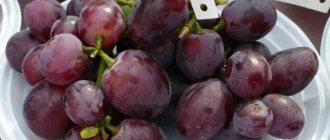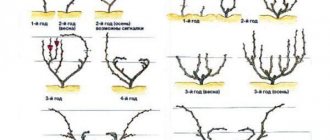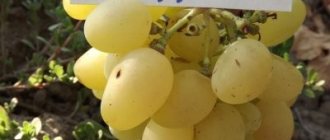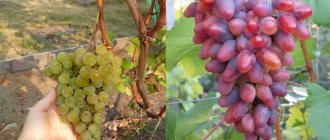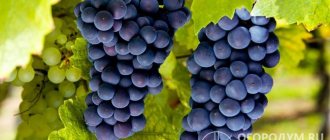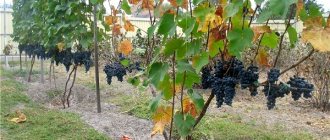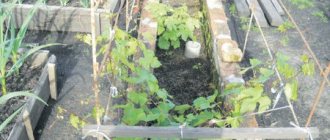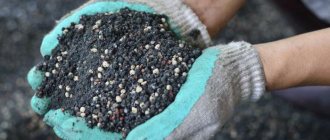In most cases, grapes are grown for fresh consumption. Various varieties are grown and sent to other cities. But not all varieties have the possibility of long-term storage. For transportation over long distances, a type of grape was bred - Chocolate.
In addition to good preservation, the variety has increased disease resistance and high yield. In order to plant it on your own plot, you need to prepare in advance and know the nuances of planting and preparing a seedling.
Description of the Chocolate grape variety (Maradona)
Resistant to diseases, the fruits do not crack and can remain on the bush until frost without harm to the crop, and their color becomes deeper and more saturated. Maradona (Chocolate) grapes are an excellent table variety, are perfectly stored, without losing either taste or marketability kind. It can be safely grown for sale, since the berries easily tolerate transportation even over long distances. The growing season for this variety lasts from 135 to 150 days.
The leaves of the Maradona grape are five-fingered, dissected, with a glossy surface. The clusters are voluminous (weighing up to 1.5 kg or more), cone-shaped, and have wings. The berries are oval, slightly elongated, the skin is thin, but not prone to cracking. The weight of each can reach 10 g. The flowers are bisexual. This means that the variety is self-pollinating.
Main characteristics of the variety
Chocolate grapes, otherwise called Maradonna red, or in some sources Taifi Sustainable or In Memory of Golodriga, is a hybrid of two equally famous varieties - Antey Magarachsky and Kata-Kurgan Kirovabad. The breeders who devoted several years to developing a new variety were Ukrainian agronomists, under the leadership of P. Golodriga.
The variety is a fairly new variety, registered in the register in 1986. It belongs to the table species, medium-late ripening. The duration of the vegetative period from the moment of bud opening to harvesting is 130-145 days. You can start enjoying ripe berries from the last ten days of August until October. This feature allows the plant to extend the harvest period of all grape crops.
Description of the variety:
- The grape has wide leaf blades of medium size, but round in shape. There is severe dissection on the surface. The leaf is divided into 5 fingers.
- The surface has a smooth structure, glossy in appearance, so when exposed to sunlight, it shines. The color of the leaves is bright green, rich tone. No additional pubescence is observed on either side.
- The petiole recess is open and vaulted. Each blade of 5 fingers of the leaf blade ends in triangular teeth.
- During the growing season, the plant does not require pollinating neighbors. The vineyard has at its disposal flowers, both male and female. Therefore, it belongs to self-pollinating plants.
- When the cluster is formed, the clusters are large, conical in shape, sometimes with a wing, the internal density of the berries remains at a moderate level.
- The weight of each brush can vary from 600 g. up to 1.2 kg. While one berry can weigh only 7-10 grams. This suggests that there are quite a large number of berries in the grapes. At the same time, the berry holds quite firmly on the stalk, not coming off until the last moment.
- When ripe, the berries turn out elegant, with a slight coating. Each bobble has an oval shape, slightly elongated in diameter. The berries are dark red, with a brown tint. The berry is dense, but at the same time the peel has a thin structure.
When eating, the rigidity of the upper shell is not felt. The inner pulp is dense, juicy, fleshy, and has a pink tint when cut. When eating grapes, an interesting aftertaste of chocolate can be seen on the tongue. Although this does not spoil the taste - the taste is delicate, interesting, subtle. Inside each berry you can distinguish up to 3 small seeds.
History of the variety's creation
The Maradona grape was bred by the famous Soviet breeder Pavel Yakovlevich Golodriga in 1981. The variety was obtained as a result of a long selection of descendants of two parent varieties - “Katta Kurgan Kirovabad Table” and “Antey Magarachsky”. In addition to the name "Maradona", it is found under the names "Chocolate", "In Memory of Golodriga", "Taifi Sustainable", "Pavel Golodriga - 12" ("PG-12") and "Maradona Red".
In 1986, the variety entered state trials in Russia and Ukraine. Now “Chocolate” can be found in the southern regions of the Russian Federation, as well as throughout Ukraine and Moldova. Moreover, it equally attracts both owners of small personal vineyards and large farm grape complexes.
Advantages and disadvantages
This variety has more advantages than disadvantages. Here are some of them:
- The clusters have a presentable appearance; the berries are not crushed in them.
- Rainy weather prevents the berries from bursting
- The grapes can be perfectly preserved on the bushes.
- Does not require special care.
- High-yielding (up to 14-15 tons per hectare).
- The harvest is well stored.
Minor disadvantages:
- It is believed that due to the color of the berries, the grapes are inferior to other varieties, and therefore are not exactly a market option, that is, for everyone.
- You can enjoy the grapes for a short time.
- You can make a mistake about the time of harvest.
Advantages and disadvantages
A relatively young specimen of grapes can boast a lot of advantages, although there are also some minor disadvantages. The following positive aspects are highlighted when growing Chocolate grape seedlings:
- The shrub is characterized by an increased growth rate of the vine. At the same time, the elongated young shoots have time to ripen well during the growing season. The length of such annual shoots can be up to 15 m on average. Rooted shoots take root well and quickly, which allows you to quickly obtain an original specimen.
- In rainy weather it does not absorb additional moisture, so the berries do not burst.
- It can hang on a bush for quite a long time without deteriorating or rotting.
- The plant has a fairly high resistance to frost. Without shelter, grapes can withstand temperatures down to -22..-250C. At elevated sub-zero temperatures, it is recommended to pre-prepare the shrub for winter. Otherwise, there is a possibility of the root system freezing, which will lead to the death of the plant.
- In most cases, the grape variety is not affected by fungal diseases, the variety is not susceptible to rot, and the plant has a slightly less chance of refraining from oidium or mildew. But judging by the reviews of gardeners, the grape variety does not suffer from frequent diseases. Therefore, you can safely plant it on your own plot.
- Chocolate grapes have a distinctive feature - they are perfectly preserved when transported over long distances and are stored for a long time after harvesting.
What are the names of the varieties of small petunia?
Features of the plant and its care The only disadvantage that the plant has is that when the bunches are collected, its shelf life ends after exactly 2 months. After this period, the bubbies begin to quickly deteriorate. Therefore, it is recommended to prepare grapes in such a way as to have time to eat them or use them for other situations during the specified period.
Comparison with analogues
Let’s compare “chocolate” with the main varieties similar to it.
| Sign | Variety | |||
| Chocolate | Lowland | Gorgeous | In memory of the teacher | |
| Ripening period | 130-140 days | 120-130 days | 100 – 110 days | 100 -110 days |
| Frost resistance | Up to -23 °C | Up to -23 °C | Up to -25 °C | Up to -23 °C |
| Yield per bush | 10-15 kg | 6 kg | Up to 10 kg | 10 – 20 kg |
| Bunches | 600-800 g | 700 g | 400 g – 1 kg | 600 g – 2.5 kg |
| Taste | Harmonious, with chocolate flavor | Harmonious and rich, sweet with a slight sourness | Muscat with vanilla | Harmonious with notes of nutmeg |
| Color | Red-brown | Red or pink purple | Gradient from pink to purple | Pink cherry |
| Disease resistance | High | High | Average | Average |
| Shelf life | Several months | Till December | 1 – 2 months | 3 months |
| Sugar content | 16-18% | 17-18% | 18 – 20% | 18 – 20% |
| Acidity | 5-6 g/l | 8-9 g/l | 6 g/l | 6 – 8 g/l |
Features of cultivation
The variety does not require special care. Standard feeding at planting and 2-3 times during the season is sufficient.
Landing
Since the variety is resistant to phylloxera, experts recommend growing it in its own root form, but cuttings are also possible. Shoots of this variety can be grafted, as they are compatible with most rootstocks.
Trimming
The grapes are pruned to form a bush and normalize the harvest.
For this variety, large pruning is recommended, because if you do a little, the shoots will begin to fatten and the harvest will be small. It is carried out as standard: in early spring or late autumn.
Diseases
The variety is not particularly painful: it is highly resistant to gray rot, and is more often affected by mildew and oidium. Therefore, grapes need at least two treatments with fungicides: before and after flowering.
Shelter for the winter
It is necessary to cover grape bushes in cold regions (after pruning). It is considered to be of medium frost resistance and can withstand up to -23°C.
The grape bushes are insulated using organic natural means: sawdust, straw, dry leaves or spruce paws - the covering method. Under the snow, with the help of an “organic pie”, a suitable microclimate for wintering will be created for him.
Storage
The grapes have properties for long-term storage, maintaining high presentation and quality. In addition, it is well transportable.
Regions
The “Chocolate” variety has a unique ability to survive well in any climate, so the variety has spread to many regions. Even in the northern regions, despite the short summer, the grapes have time to ripen and bear fruit. But it feels especially good in the southern regions.
Suitable for cultivation in the Moscow and Leningrad regions.
Features of variety propagation and planting cuttings
The Maradona variety has spread to many regions due to its unique ability to survive well in any climate. Even in the northern regions, the Chocolate grape variety manages to bear fruit, despite the short summer.
Maradona grape seedlings are planted in a sunny place on the south side of the site. Shading has a bad effect on the harvest. Due to lack of sunlight, the berries may not turn red and will remain white with a greenish tint. The variety loves nutritious soil with good drainage. Chocolate grapes will not grow in swampy areas.
Advice! Maradona bushes develop well near a fence or near buildings. Artificial barriers protect grapes from cold winds and drafts.
Planting seedlings of the Chocolate variety is practiced in autumn and spring. In cold regions, planting is preferable in early May once warmer weather sets in. In a short summer, the seedling will have time to take root and survive the winter well. Gardeners in the southern regions practice autumn planting.
In addition to propagation by seedlings, the Maradona grape variety is well propagated by grafting. The rootstock is used by young and mature. For any method of propagation, cuttings are prepared in the fall. During pruning, the top part of the vine is discarded. She is usually immature. The rest of the lash is cut with pruning shears into cuttings with 4–5 eyes. To preserve the juice, the sections are dipped in hot paraffin. The cuttings are wrapped in damp cloth and stored in the cellar or refrigerator until spring.
The simplest way to graft Chocolate grapes is into splits. The process consists of the following steps:
- An adult bush is chosen for the rootstock. The vine is cut until a stump forms.
- The lower part of the cutting is cut off from opposite sides with a sharp knife. You should get a wedge.
- The stump of the rootstock is split in the center with a knife. A cutting is inserted into the split using a wedge, tied tightly with fabric tape, and covered with clay on top.
Maradona grapes can be grafted onto a young rootstock with an eye or into an overlay. In the second method, a rootstock and scion of the same thickness are selected.
The video demonstrates cleft grafting:
To grow a seedling from a cutting, perform the following steps:
- At the beginning of February, cuttings are taken out of the basement. Using pruning shears, cut off the lower part, filled with paraffin.
- Using the sharp tip of a knife, scratch the bark of the cutting near a fresh cut about 2 cm long. It will be easier for roots to grow from the grooves.
- Cuttings are placed in water, wet soil or wrapped with moss and film on top. In April, sprouted Maradona grape seedlings can be hardened off outside. If germination was carried out in water or moss, after the roots appear, the cuttings are planted in pots with soil.
Planting seedlings of the Maradona grape variety begins in early or mid-May. The timing depends on weather conditions. The planting rules are the same as for other grape varieties:
- The hole for the Maradona seedling is prepared in the fall or no later than a week before planting. A hole is dug with a depth and diameter of about 80 cm.
- About 50% of the pit is filled with a mixture of fertile soil and compost. Potassium and phosphorus fertilizers are added. If the soil is heavy, sand is added to loosen it. Before filling, the bottom of the pit is equipped with drainage made of stone or broken brick.
- A Maradona grape seedling is carefully removed from the pot along with a lump of earth, lowered into a hole and covered with soil. After watering, the soil will settle. It needs to be topped up and covered with sawdust or peat mulch on top.
On the market, seedlings of the Maradona variety are often sold with bare roots. When planting such grapes, a mound of soil is formed at the bottom of the hole. The root system of the seedling is straightened over the hill, after which backfilling begins.
Pruning and care
Since Chocolate is a hybrid variety, it is not very demanding. High frost resistance for grapes (from -23 to -26) will allow you to cover them less tightly.
Hybrids also include the well-known Korolek, Valery Voevoda and Rumba.
For planting, we choose a place with maximum sun exposure to the plant; the soil must be well fertilized with minerals if you want to ensure the highest possible yield.
The bushes will be vigorous. 60 eyes are the optimal load on the bush. Pruning of the vine is carried out at 7 - 8 buds and monitored throughout the season. It is worth noting that the fruitfulness of the shoots reaches 80%.
Senator, Alexa and Svetlana are also frost-resistant.
Rules of care
Normal development of culture is impossible without high-quality and complete care. It must certainly be comprehensive.
Watering mode
Water the crop only as needed. It is recommended to moisten the soil only when the top layer has dried. In hot weather, this should be done at least once a week. In this case, the soil should not acquire a swampy structure.
The soil should also be moistened when the fruits are poured and before harvesting. The last watering is carried out before sheltering for the winter.
After the soil is moistened, a crust usually forms. It is worth getting rid of it to provide the plant roots with moisture and oxygen. During loosening, it is possible to get rid of weeds. To keep the soil moist longer, apply a mulch layer. You can use straw or sawdust for this.
Top dressing
In the first 2-3 years after planting, the plant does not need fertilizers. During this period, the fertilizers that were used during planting are enough. Older crops require the use of complex fertilizers. It is recommended to use organic matter periodically.
Trimming
The grapes of this variety are characterized by rapid growth and therefore require systematic pruning. The manipulation should be performed in autumn and spring. In the first case, you should cut off excess growth and clear the bush of dry branches.
If there is enough free space, it is recommended to form grapes of this variety into 2 shoulders. The bush is considered quite hardy, therefore it is allowed to leave a maximum of 60 eyes on it. 7-8 eyes are removed from each shoot. This load is considered the maximum permissible.
Protection from birds and insects
This plant may suffer from attacks by birds and insects. To avoid such problems, it is necessary to use special nets to protect the bunches.
Preparing for winter
It is recommended to prepare grapes for winter only in the center or north. However, in cold areas the crop is practically not grown, since its fruits do not have time to ripen. In the south, plantings do not need to be covered.
To prepare the plant for winter, it is worth removing the vine, placing it on a spruce branch and covering it with non-woven material. Special agrofibre is also suitable. When snow falls, it is worth adding additional snow to the plant.
Preventive spraying
The plant rarely encounters dangerous diseases, but it is not recommended to neglect preventive spraying. Fungicides that are used before and after flowering will help to avoid fungal infections. Medications containing copper help to cope with the problem.
Conditions for landing
You need to find a place to plant grapes that is sunny, warm, and not blown by winds on the south side. It is better if the vine grows next to the wall of the building, retreating 1 meter from it.
Almost any soil with moderate acidity is suitable, with the exception of salt marshes, wetlands and lands with close groundwater flow.
After choosing a site for planting grapes in the fall, you need to apply fertilizer and dig up the soil.
It is better to plant grapes in the spring, after the end of frost, so that by the onset of winter cold the vine has grown and become stronger.
Seedlings are either purchased in specialized stores or grown from cuttings yourself. Planting is carried out according to the usual pattern.
All about planting a seedling
A seedling of the Chocolate grape variety can be purchased at specialized markets or grown from cuttings. When choosing a sprout with a closed root system in the store, you should carefully examine the stem. It should have green leaves.
If the plant is selected during the cold period, then the cuttings should be alive, the buds should be swollen and ready to open (if this happens closer to spring). When you cut the top peel from the trunk, the green structure of the plant should be visible underneath. There should be no rotten areas or areas with damaged bark on the surface of the seedling.
It is necessary to choose high-quality, healthy seedlings that can further develop and produce abundant harvests.
If the cutting is prepared independently, then it must be cut from the bush in the autumn. Pre-soak in a solution of Potassium Permanganate, treat open sections with paraffin to prevent pathogenic bacteria or parasites from entering the stem. After all the preparations have been completed, the cuttings are placed in a cold room with a temperature no higher than 0..+2 C. This is necessary so that the seedlings undergo natural stratification and harden.
At the end of February - beginning of March, the seedlings are removed and soaked again in a solution of potassium permanganate and a growth stimulant. Only after this is planting done in containers or open ground. Landing in open areas is carried out at a time when the air temperature reaches +20..+25 C.
Landing rules:
- Holes for planting are dug up to a depth of 1 m in diameter, just down to the crushed stone layer. A tube for internal watering and ventilation is installed in the corner. Fertile soil is poured into the bottom and a cutting is placed on top.
- If the seedling has an open root system, then the rhizomes are carefully examined and those affected by rot and damaged are removed. Fresh sections are sprinkled with wood ash or crushed activated carbon.
- To plant, you should pour a small hillock of soil and place the seedling on it, carefully straightening the rhizomes. After this, cover with soil, but so that the soil completely covers the rhizomes, leaving no hollow surfaces.
- If the seedling takes root without roots, then it is necessary to place the cutting so that only 1 bud is on the surface. All the rest - 4-5 were rooted in the soil substrate.
- After rooting, fertile soil is poured on top. The area near the base of the plant is carefully compacted and spilled with water. To reduce moisture evaporation, you need to mulch the surface.
Site and soil preparation
In order for the shrub to develop quickly and delight you with a constant abundant harvest, it is necessary to select the best site before planting and pre-prepare the soil. If all the requirements are met, then the plant will never know what downy and true powdery mildew is, as well as a number of other diseases.
You should adhere to the following rules for choosing the optimal location for Chocolate grapes:
- The best place for planting is loamy soils, sandy loam soils or chernozem substrates.
- For planting, choose southern sides with plenty of sunlight. Ideally, the place where the plant will permanently live is on a slope. This is necessary so that wastewater or melt moisture does not stagnate near the rhizomes of the plant, provoking the formation of putrefactive diseases.
- Before digging, you should check the depth of groundwater. It should be at a level of no less than 2.5 m. This is an important aspect because the rhizomes of the Chocolate variety tend to grow 0.8-1 m wide and 1-1.5 m deep.
- You should not place seedlings in areas where a cold north wind constantly blows and there are cold drafts. In such a situation, the plant tends to be susceptible to diseases.
- It is necessary to check the acidity of the soil during planting. It should be at the optimal level of 5.5-6.5. On acidic or salty soils, the seedling will sit in one place and not develop.
- Before burying the cuttings in the ground, it is recommended to check the soil for the presence of nutrients. If the soil substrate turns out to be depleted, then the seedling will form roots for a long period, and when the harvest appears, the brushes will not differ in large size and taste.
Aurora haircut for short hair. Photo, front view, back view, with bangs, for a round face. Execution technique
After choosing the optimal site, you need to prepare the soil. It is recommended to engage in selection and preparation in the autumn. This is necessary so that the dug area has time to be saturated with the applied organic and mineral fertilizers, and also to settle to the required level.
To prepare the trench before planting the seedling, you should choose the direction of the trench if several cuttings are planted.
In such a situation, dig holes 1 m wide and 4 shovels deep. The direction should be chosen from north to south. Humus is added to the dug hole in the amount of 10 kg per 1 m2. and nitroammophoska in a volume of 60 g. per 1 m2. These components are mixed together. A small layer of large-format crushed stone is laid out on them. It is necessary so that excess moisture does not stagnate in the roots of the grapes.
Afterwards, a layer of garden soil 30 cm in size is laid out. After this, the backfilling of nutrients and garden soil is repeated again, but without adding crushed stone, so that the trench is completely compacted. The soil is left in this form until the onset of warm spring days.
Vineyard care
When reviewing the detailed description of the Chocolate grape variety, photos, and reviews from gardeners, it is worth paying attention to caring for the crop. There are no special requirements, but weeding, watering and fertilizing need to be done. In autumn, pruning followed by covering is required. The last step is necessary for cold regions.
The frequency of watering the Maradona variety depends on weather conditions. The soil is kept moist but not waterlogged. Chocolate grapes must be watered four times per season:
- before flowering;
- while pouring berries;
- at the end of the harvest;
- late autumn before shelter.
To avoid crust formation, loosen the soil with a hoe after each watering. To preserve moisture and provide additional feeding, the ground under the bushes is covered with a thick layer of mulch.
Advice! If peat or sawdust is difficult to obtain, grass clippings can serve as mulch.
Fertilizing helps the bushes develop, increases the yield and taste of the berries. The Chocolate variety vineyard loves organic matter: compost, rotted manure, humus. The bushes are topped with a solution of chicken manure and fertilized with complex fertilizers.
It is advisable to feed the Chocolate variety at least 3 times during the season:
- immediately after flowering;
- when the grapes ripen;
- in the fall before wintering.
The final feeding of Maradona grapes is done with potassium fertilizer. Accumulated salts increase the vine's tolerance to severe frosts. Manure is applied in the form of slurry. Dry compost can be scattered instead of mulch 10 cm thick. Mineral fertilizers include saltpeter, potassium chloride and superphosphate. Fertilizers are applied simultaneously with watering. Sometimes combined with spraying with preventive drugs against fungus.
The Chocolate variety is characterized by strong bush growth. In autumn the vine is pruned. Each gardener has his own favorite way to form a bush. It's easier to create a fan. If there is a lot of space on the site, two shoulders are formed from the bush. In the courtyard you can let the lashes fall on the arch, organizing a place to rest under the Maradona grapes.
In the south there is no need to cover the vine. Chocolate grapes are grown in standard form. Bushes in the form of a low tree remain overwintering on supports.
In cold regions, Maradona grape bushes are covered after pruning. A straw shield is created on the ground. The vine is tied with ropes and laid on a mat. The top of the Chocolate grapes is covered with thick material or reed mats are knitted.
Important! When pruning Maradona grapes, up to 45 eyes are left on an adult bush. The lashes are trimmed, leaving a maximum of 8 eyes.
Diseases and pests, combating them
In most cases, the Chocolate variety is not susceptible to disease or parasite invasion. But there are situations when the bush is affected by rot, downy mildew or oidium. When yellow spots appear on the leaf blades, which are subsequently covered with a whitish coating, we can talk about the plant acquiring rot. If the plant is not treated, the fungus migrates to the stems and brushes.
Infected fruits in such a situation should not be eaten. To prevent the appearance of any disease, it is necessary to spray it with chemicals that are effective for various diseases during the formation of the ovary. Preventive measures should be carried out periodically by spraying with copper sulfate or other substances. This is necessary to eliminate the preconditions for diseases such as chlorosis, bacterial cancer, and anthracnose.
If pests are found on the plant in small quantities, they must be removed mechanically or manually. In case of serious damage, it is recommended to treat the plant with folk remedies or chemical insecticides.
The most common parasites observed on the plant are aphids, phylloxera, thrips, and spider mites.
To prevent any infection of the vineyard, you need to monitor the condition of the plant. If any signs of the disease appear, begin treatment immediately and do not wait for the situation to develop seriously. Thus, the Chocolate grape variety is a productive variety that can be stored for a long time and does not burst under the influence of rain. The main thing is to properly prepare the soil and planting material, and also plant it in open ground. proper care will help to grow the plant and get a rich harvest.
More information can be found in the video:
Reviews
Subject to simple rules in cultivation and care, the “chocolate” grape variety will give its owner a rich harvest.
Overall rating
This hybrid variety is not very demanding and has good winter hardiness. Relatively resistant to diseases. Positive characteristics also include excellent taste and external characteristics, which makes it possible to grow grapes for sale. In addition, it is characterized by high productivity, the possibility of transportation and long-term storage.
The variety certainly deserves the attention of gardeners. Despite the fact that it is mainly distributed in the southern zones, due to its unpretentiousness it can grow almost everywhere.
Disease Prevention
Despite the fact that the “Chocolate” variety is rarely affected by phylloxera and oidium, for prevention purposes it is better to treat it with special preparations - “Colloidal sulfur” or “Fitosporin-M”.
The situation is slightly worse with mildew - downy mildew. To prevent the spread of this disease, grape bushes should be sprayed with fungicides before and after flowering. Copper-containing preparations, for example, a 1% solution of copper sulfate, also help well.
Did you know? Since ancient times, people have treated grapes with respect. Its grapes were depicted on coins and kitchen utensils. Grapes are also mentioned in Homer’s legendary Odyssey, ancient Greek manuscripts and Babylonian cuneiform.
Thus, Maradona grapes, with proper care from the gardener, will show excellent taste and be used for making wines and juices. And its advantage, such as good disease resistance, makes its cultivation not particularly difficult, although preventive measures are mandatory.


